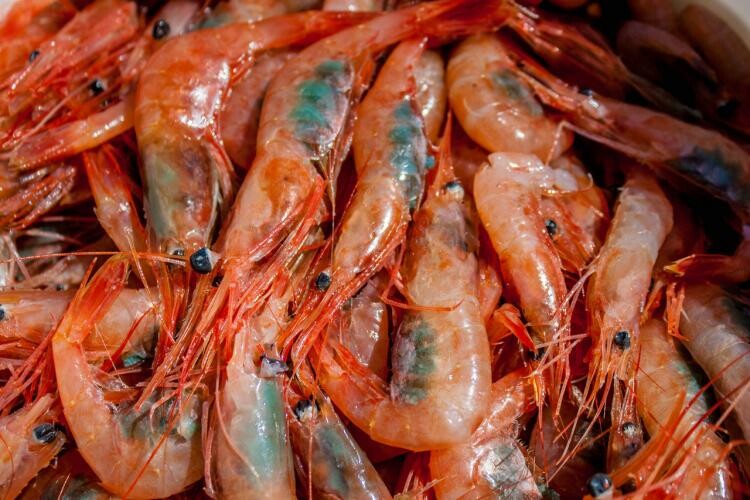It is almost certain that Maine shrimp will not be on any menus, or in markets this year.
The Maine shrimp (pandalus borealis — also known as northern shrimp and pink shrimp) had its last commercial season in Maine in 2013.
Back then, dealers paid fishermen an average of $1.81 a pound. But since then, the fishery has been closed, aside from a few years of limited catch for research purposes, with very small amounts of pricy shrimp making it to markets. Shrimp thrives in cold water. Warming waters, have made life hard on the species.
In 1962, shrimp was 15 cents per pound at the dock. By 1995, it was worth 90 cents and valued at $10.67 million, according to Maine Department of Marine Resources data. Marshall Alexander, 75, who works out of Portland, has been a commercial fisherman for six decades. Back in the day, Marshall caught a lot of shrimp on his boat, the De Dee Mae II.
“I used to get three-fourths of my pay catching shrimp,” Alexander says. “I was very good at it... I hate to say it. I figured out where they go.” Alexander feels there are shrimp populations out there, waiting to be caught. “I hope we have a season,” he adds.
But things are not looking promising. While northern shrimp in the Gulf of Maine are not extinct, says Maggie Hunter, lead shrimp scientist at Maine’s DMR, they have declined in abundance by 90 percent (the total biomass index average for 2014-19 was about 10 percent of the 1984-2013 average, according to a 2019 report).
“Their range has contracted but they aggregate in schools and they can still be found and caught at a high rate; a good fisherman with some luck and some years under his belt will know where to look,” says Hunter.
But a high catch rate does not mean the stock is abundant, cautions Hunter. While some think shrimp in Canadian waters are doing better, Nova Scotia data shows steady declines since 2004, while Shelf and Newfoundland and Labrador shrimp stocks are also down, possibly a result of higher fish predation. The Gulf of St. Lawrence area shows mixed results.
While the current moratorium on Maine’s fishery is set to expire in 2021, factors make it unlikely regulators will support a reopened fishery this year. “The only new data we have at this time are from the fall 2020 Maine-New Hampshire Inshore Trawl survey,” says Hunter, “which had the lowest abundance in that survey’s time series, and very little recruitment from the 2020 year class.”
Dustin Colson Leaning, a fishery management plan coordinator for the Atlantic States Marine Fisheries Commission, says when regulators meet this winter, they “will consider the results of the 2021 Northern Shrimp stock assessment update among other biological, economic and cultural considerations.” If there happens to be a decision to reopen the fishery, regulators will also need to specify the total allowable catch, the season length, trip limits, and trap limits for 2022, along with consideration for days out of the fishery, and a research set-aside.
“It can feel disheartening to join a conservation effort at all-time population lows and only hear stories about how abundant these species used to be years ago,” says Learning, who works on northern shrimp and winter flounder. Both are struggling to remain viable fisheries. “However, there are conservation success stories, such as the rebound of the northern shrimp population after stock collapse in 1978, that inspire me to continue my interest in this species.”
There is a vested interest among scientists, fishermen and the coastal communities to understand and support northern shrimp — and part of that is understanding the past.
“I would like to study the massive recruitment event that occurred in 2002... to learn more about the interplay between environmental conditions, predator pressure, and stock dynamics that allowed for an estimated 36 billion shrimp to recruit to the stock that year,” says Learning.
Maggie Hunter adds: “I’d like to know more about what happened in the early 1950s, when temperatures were high and shrimp were scarce.”
Hunter is also very interested in learning more about what might have happened in 2012 and ’13, when the Gulf of Maine stock suddenly shrank. Recently, Hunter and Anne Richards published a paper about longfin squid coming into inshore Gulf of Maine earlier and with greater overlap of the shrimp population than usual in 2012. The paper says longfin squid are voracious predators, and considers how they might have eaten vast amounts of shrimp.
“It’s all just speculation, though, because there is very little data on the stomach contents of the squid because they thoroughly masticate (grind up) their food, and there was no assessment of whether the squid were abundant enough to have had that much impact,” adds Hunter, “although they were much more abundant than usual.”
As for Alexander Marshall, he now focuses on groundfish. But he fondly remembers catching Maine shrimp and preparing them fresh aboard his boat.
“We’d put them in a cooker, and in two minutes, bail them out and eat them really quick. That was the best shrimp I ever had!”







